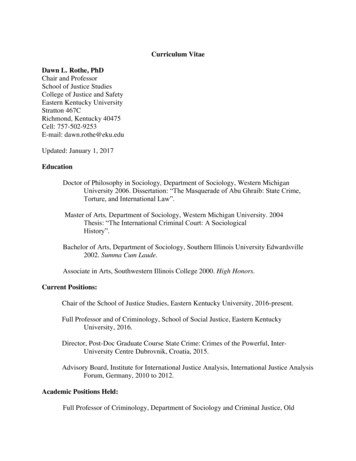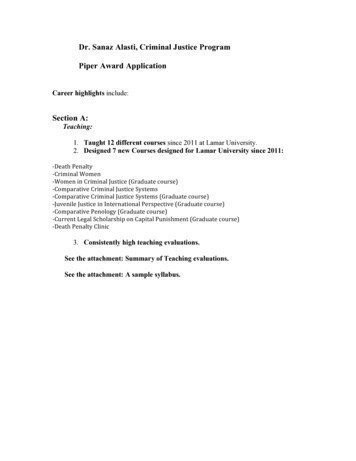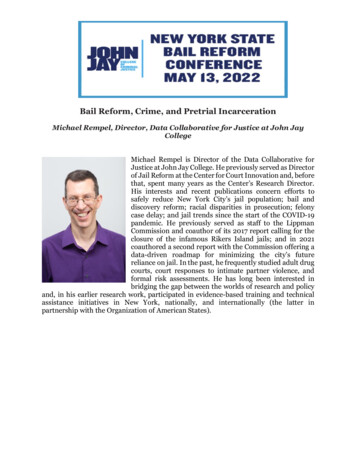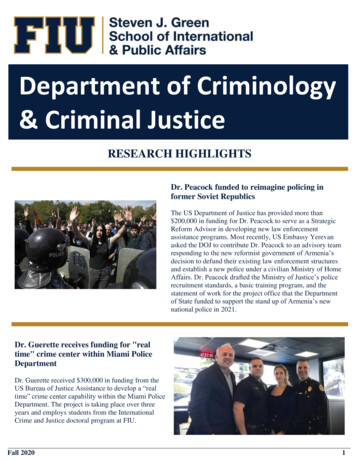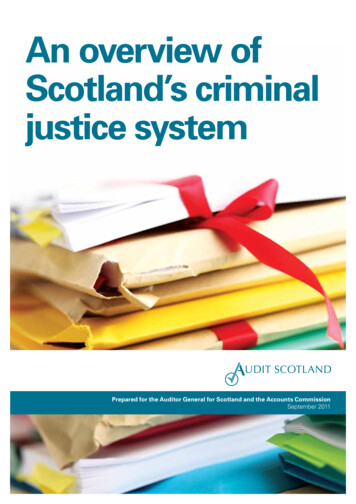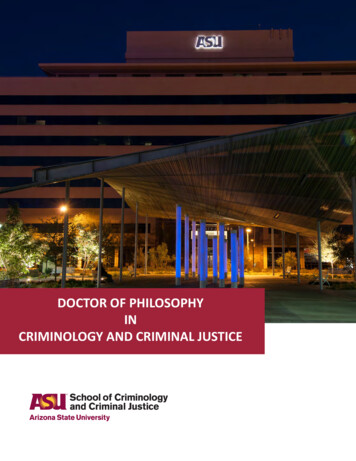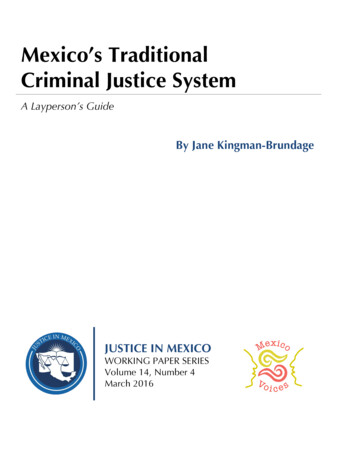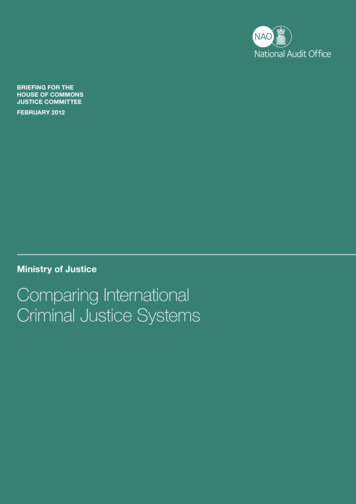
Transcription
CRIMINAL JUSTICE RESPONSES TOEMERGING COMPUTER CRIME PROBLEMSOsman N. Sen, B.S.Thesis Prepared for the Degree ofMASTER OF SCIENCEUNIVERSITY OF NORTH TEXASAugust 2001APPROVED:Robert W. Taylor, Major Professor andChair of the Department of Criminal JusticeTory J. Caeti, Committee MemberBradley Chilton, Committee MemberDavid W. Hartman, Dean of the School ofCommunity ServiceNeal Tate, Dean of the Toulouse School ofGraduate Studies
Sen, Osman N., Criminal justice responses to emerging computer crime problems. Masterof Science (Criminal Justice), August 2001, 133 pp., 4 tables, 3 illustrations, 100 references.This study discussed the issue of computer crime as it relates to the criminaljustice system, specifically law enforcement. The information was gathered throughseveral books, academic journals, governmental documents, and the Internet. First, thenature and forms of computer crime, Internet crime, and cyber terrorism were analyzed.Next, law enforcement responses were discussed. International aspects of the problemwere separately pointed out. Further, detection and investigation of computer crime wereexamined.Problems related to the each component of the criminal justice system (lawenforcement, investigators, prosecutors, and judges) were described. Specific solutions tothese problems were offered. In addition, computer crime handling procedures werepresented.Results indicate that computer crime will increase in the 21st century, and thisproblem cannot be controlled by traditional methods alone. Using new technology aspreventive measures, and increasing awareness and security conscious culture willprevent the problem in the long run.
ACKNOWLEDGEMENTSI am very thankful to my committee chair Dr. Robert W. Taylor for his guidance,information, and support in this thesis. I also appreciate the help of committee membersDr. Tory J. Caeti and Dr. Brad Chilton. I want to express my appreciation to theUniversity of North Texas Libraries where I have conducted most of my research. I alsothank the Turkish National Police for providing me financial support for this degree.Finally, I want to extend my deepest appreciation to my wife, Hikmet, for her love,patience, understanding, and encouragement.ii
TABLE OF CONTENTSACKNOWLEDGEMENTS. . iiTABLE OF CONTENTS. . iiiLIST OF TABLES .vLIST OF ILLUSTRATIONS .viCHAPTER1. INTRODUCTION 1Purpose of the StudyBackgroundScope/Limitations of the StudyMethodology of the StudyImportance of the Study2. COMPUTER-RELATED CRIME .10IntroductionComputer CrimeInternet CrimeCyber TerrorismIllustrative CasesStatisticsProfiles and Motives of Computer Criminals and HackersTheoretical Explanations of Computer CrimeConclusion3. LAW ENFORCEMENT RESPONSE TO COMPUTER CRIME.IntroductionWhat Should Law Enforcement Agencies Do?Equipping Law EnforcementComputer Crime LawsInternational Aspects and Jurisdiction IssuesDetecting Computer Crimeiii44
Investigating Computer CrimeConclusion4. PROBLEM ANALYSIS .78Problems Related to Law EnforcementProblems Related to InvestigatorsProblems Related to Prosecutors and JudgesGeneral ProblemsConclusion5. SOLUTION ANALYSIS .90Computer Crime Handling ProceduresSpecific Solutions for Criminal Justice ComponentsGeneral SolutionsConclusion6. DISCUSSION/CONCLUSION.111Review of the Chapters and Basis for Each ChapterRecommendationsFuture ResearchAPPENDIX . . 118REFERENCES 122iv
LIST OF TABLESTablePage2.1. Profile of the Typical Computer Criminal .372.2. Motives of Computer Criminals by Industry, andthe Number of Companies Citing Each Motivation 385.1. Computer Crime Handling Strategy. . .915.2. Sources of Computer Crime Incidents 97v
LIST OF ILLUSTRATIONSFigurePage2.1. Financial losses . .352.2. The “Triangle of Crime” . .414.1. Attack Sophistication vs. Intruder Technical Knowledge 86vi
CHAPTER 1INTRODUCTIONPurpose of The StudyThis study addresses the issue of computer crime as it relates to the criminaljustice system, and especially law enforcement. The entire criminal justice system,including investigators, law enforcement personnel, prosecutors, and judges, are facedwith the challenges posed by computer crime. Further, this study describes the impact ofcomputer crime on society and its institutions. A model for law enforcement to respondto computer crime is also presented.BackgroundWith the enormous advances in the computer and telecommunication industries,computers are now being used in almost all walks of life all over the world. Indeed,computers today touch every aspect of society including the financial industry,manufacturing industry, universities, insurance companies, law enforcement, andgovernmental agencies. With the advent of the Internet, computer usage has also spreadto most individual homes. According to the Computer Emergency Response Team(CERT), the projected number of Internet host computers was 13 million in 1996, 85million in 1998, 370 million in 1999, and 900 million in 2000 (Cain et al., 1999). Theestimated total number of the Internet users (people who are ‘online’) worldwide as of1
November 2000 is 407.1 million (www.spcustom.com). We are so surrounded bycomputer systems that we cannot avoid interaction with them. This interaction providescomputer criminals the opportunity to wreak havoc (e.g., shut down systems, interrupttelephone services, disrupt air and highway traffic, cease bank operations and exchangemarkets, remotely alter the formulas of medication at pharmaceutical manufacturers, orstop utility services) by using high-tech communications systems. In some cases, ourinteraction with computer systems is evident, such as when we use an automatic tellermachine. However, in other cases our computer interaction may not be so apparent, suchas when we use telephone services.Computer technology provides the ability to collect and analyze large quantitiesof data very easily and rapidly, as well as the ability to transmit data throughout the worldthrough the use of the Internet. Through computer technology, governments can collectdata about specific events, and businesses can collect vital statistics and other informationabout customers and their purchasing habits.New technologies have always brought problems as well as solutions. The use ofcomputer technology has not only helped governments, businesses, and individuals, but ithas also enabled criminals with sophisticated computer knowledge to use computers inillegitimate ways. Computers offer criminals the opportunity to break laws, andcomputers offer the ability to commit traditional crimes in non-traditional ways.Computers and computer systems may be targeted by criminals because of theirvarious idiosyncratic vulnerabilities. Vulnerability has increased following the abrupt riseof computer networks. As the most important aspects of national infrastructure become2
dependent on computer technology, security issues have received more attention. Mostsecurity systems are powerless because of the difficulty of detection. Scarcity ofsuccessful detection is due mainly to the vagueness of time and space dimensions oftenobserved in computer crime. It is difficult to determine when and where computer crimeoccurs. Indeed, computer criminals do not attack with explosives or dynamite; instead,they use telecommunication and other technologies. In other words they attack with‘ones’ and ‘zeroes’.The potential damage done by computer-related crime can be more extensive thanin traditional crime. Indeed, computer crime may involve large amounts of money incyberspace. The aggregate losses to governments, businesses, and individuals areestimated to be in the billions of dollars (Aldrich, 2000). Therefore, it is argued thatcrimes committed through the utilization of computers are now more harmful than socalled traditional crime. Furthermore, organized crime has entered the cyber crime arena.This offers support to the age-old diction: “where money accumulates, so do criminals.”In contrast with traditional security issues, law enforcement does not have enoughexperience and knowledge in ways to protect computers and networks from these kindsof crime. Thus, most computer crime incidents go undetected. Statistics on computercrime are generally not available. This is due to several reasons, such as reluctance ofvictims to report incidents, and uncertainty of exact definitions and classifications.Despite the absence of accurate statistics, it is generally agreed that the problem ismonumental and is continuing to grow (Peters, 1997).3
The expansion of worldwide access to the Internet foretells that computer crimewill continue to increase. Recently, devastating computer crime incidents have occurredover the Internet such as the denial-of-service attacks to several major commercial websites in 2000 (e.g., E-bay, Yahoo, E-trade etc) (Government Prepares, 2000).Additionally, the dissemination of the Melissa virus through the Internet in March 1999provided dramatic evidence of the significant damage that results from these types ofattacks (Computer, 2000). These incidents have fueled the debate on control of theInternet. In most cases, local law enforcement agencies do not have the personnel,equipment, and practical knowledge to proactively detect computer crime. The lawenforcement community today is required to keep up with the rapidly growing use ofhigh technology. Hence, growth of computer crime requires police officers that arefamiliar with advanced technology. It is also imperative that prosecutors, investigators,and judges have significant knowledge of computers and computer systems. In otherwords, the problem demands crucial and quick attention.Increasing concern about the threat of computer crime has forced the U.S.Department of Justice to request a 37 million budget increase for the year 2000(Government Sees, 2000). The Justice Department announced that 8.6 million of thismoney would fund 100 “Computer Analysis and Response Team” members who wouldinvestigate computer-related crime (Government Sees, 2000).Also, international cooperation is required to fight computer crime. A globalframework must be developed to address all types of computer crime. To maintaininternational response, the Justice and Interior Ministers of the G-8 (Canada, England,4
France, Germany, Italy, Japan, Russia; formerly known as the G-7 plus Russia) at ameeting held in 1997, in Washington D.C. made the decision to combat computer crime(Computer, 2000). The global nature of computer crime, especially over the Internet,requires a global consensus on computer crime and their regulation.Most industrialized countries have enacted laws against computer crime since the1970s. The first computer-specific laws concerned the protection of privacy. However, inthe 1980s, the focus shifted to computer-related economic crime. Protection ofintellectual property also has become an important issue in computer legislation.Conventional ways of thinking undervalues the importance of computer crime.Officials are missing the important part of the problem—the intrusions that are notdetected. Before prevention and detection can occur, the problem must be described.Therefore, in this study, this new threat is discussed. This study provides a descriptiveanalysis of computer crime including the nature of computer crime, several illustrativecases, and relevant statistics pertaining to computer crime. Analysis, detection,investigation, and appropriate preventive measures are then addressed. In addition, thisstudy identifies problems that police may face during the investigation of a computercrime. The law enforcement perspective, the current situation of the law enforcementresponse, and what agencies must do in order to catch up with the demand are discussed.Finally, an overall discussion of computer crime concludes this study.5
Scope/Limitations of the StudyThe scope of this study includes, but is not limited to, computer crime committedusing personal computers, network computers or remote terminals communicating with aremote computer or server via modem. Because of the advent of the Internet, the focus ison events occurring after 1980. A technological shift toward a more distributed (versuscentralized) computer environment in the 1980s significantly changed the face ofcomputer crime, especially because of increased access to computers by a great numberof people.There are several limitations that naturally arise from any study on computercrime. For example, there is currently no single data source that provides in-depth,reliable and accurate information on computer crime or computer criminals. Unlike othertypes of crime (e.g. murder, robbery, burglary), there are no national statistics or uniformreporting systems for computer crime. In addition, there is limited information aboutcomputer crime incidents in academic literature. Indeed, the literature contains somespeculation. However, no information has been rigorously collected using scientificmethods. The most popular data source is a survey conducted by the Computer SecurityInstitute (CSI) and sponsored by the Federal Bureau of Investigation (FBI). Anothersignificant limitation to this study is that computer crime is rarely detected. It is oftendifficult to determine how the offence was committed. Indeed, accurate time and spacefeatures of a computer crime may be vague. Further, there are no universally accepteddefinitions or classifications of computer crime. As such, centralized statistics would bedifficult or impossible to collect. The final limitation of this study is the reluctance of6
institutions, businesses, and individuals to report computer crime. According to someresearch, the incidents that are not detected far exceed those that are detected. In essence,what is reported is thought to be only tip of the iceberg (Adamski, 1998; Lohr, 1997,Grabosk, 2000).Methodology of the StudyThis study utilizes focused synthesis methodology to analyze computer crime.Focused synthesis is defined as gathering information related to and based on researchquestions from a variety of sources (Doty, 1982). A focused synthesis is similar totraditional literature reviews; however, it differs from traditional literature review studiesin three primary ways: 1) Focused synthesis is not drawn from only published articles, itmight also include the researcher’s thoughts, personal past experience, unpublisheddocuments, and congressional hearings; 2) The purpose of focused synthesis is tocombine available sources on a subject. Focused synthesis has a different purpose thantraditional literature. Focused synthesis is done less formally, and it does not aim only todescribe prior research. 3) Finally, focused synthesis is prepared to be used as a study togive much detail on a subject. Yet, most research studies tend to be a background for laterstudies. Focused synthesis attempts to derive results and policy recommendations basedon the information gathered in a study (Majchrzak, 1984). These features provide focusedsynthesis some advantages; such as it can be completed efficiently, quickly, and in amore realistic manner (Majchrzak, 1984). Yin (1994) posits two relevant and importantdata collection sources for a study of this type: documentation and archival records.7
Documentation and archival records are stable and unobtrusive; however, they reflectbias of authors (Yin, 1994).This study utilizes the available research from academic journals and books,government documentation and data, and current research available online. The ultimategoal of this is to analyze available material on computer crime and enforcement practicesin an effect to provide a comprehensive picture of what computer crime is and what isbeing done about it.Research QuestionsIn focused synthesis methodology, the researcher tries to find answers to certainquestions. This particular study attempts to answer the following: What is computer crime, and how are the different types of computer crimecategorized? What are the demographic, social characteristics, and modus operandi” ofcomputer criminals? What should law enforcement agencies do to investigate and prosecute computercrime? What are the current computer crime laws? What are the international and jurisdictional problems of computer crime? What is the most important computer crime prevention measure: technology, lawsand regulations, or awareness?8
Importance of the StudyThis study is important because it provide detailed descriptions of the three partsof computer-related crime, which are computer crime, Internet crime, and cyberterrorism. In addition, law enforcement response to computer-related crime is discussedin-depth.9
CHAPTER 2COMPUTER-RELATED CRIMEIntroductionThe number of people using the Internet reached 50 million within a four-yearspan (Levesque, 2000). Like other technologies, it was only a matter of time beforecrimes would be committed utilizing the Internet and computers. To address thecomputer-related crime problem effectively, the nature of the problem needs to beunderstood in detail. In this chapter, three main aspects of computer-related crime arediscussed: computer crime, Internet crime, and cyber terrorism. Computer crime is anyillegal act committed by a person who has knowledge of computer technology. There areseveral types of computer crime that will be discussed. Internet crime is any type of crimecommitted via the Internet including attacks, viruses, and more traditional types ofcrimes. Cyber terrorism uses computer knowledge to commit or to facilitate a crime forpolitical purposes. Each one presents unique issues for academic research and for lawenforcement.Computer CrimeDefinitionsSeveral authors have attempted to define computer crime, including:“Computer crime is any violation of a computer crime statute” (Parker, 1981).10
“The destruction, theft, or unauthorized or illegal use, modification, or copying ofinformation, programs, services, equipment, or communication networks” (Perry,1986).“Any intentional act involving knowledge of computer use or technology iscomputer abuse if the perpetrator could have made some gain and the victimcould have experienced loss” (Parker, 1989).“Mostly hidden criminality where there is small probability of detection, a highreluctance to report, and inadequate security” (Tenhunen, 1994).“Computer crime (computer abuse) is the use of a computer to deceive forpersonal gain” (Strothcamp, 1998).“Crimes directed at a computer or a computer system” (Stephenson, 2000).Computer crime takes several forms such as theft, destruction of data or systems,unauthorized use or copying of data, and alteration of data, viruses, trojan horses, logicbombs, and vandalism. The nature of computer crime has become increasingly complex,as technology and the Internet have grown.Categories of Computer CrimeA simple definition of computer crime is elusive; therefore, categories ofcomputer crime are offered for clarity. As in the definitions, there is diversity in thecategories and types of computer crime. In this study, four major areas of computer crimeare discussed.Role of ComputersThe first, and widely accepted area classifies computer crimes in terms of the rolethat computers play. In this area, computer crime falls into one of four types: computers11
as the end target, computers as the means (instrumentality), computers as incidental toother crimes, and crimes associated with the prevalence of computers (Carter, 1995).These computer crime types provide a useful typology for this study.Computers as the end target: In this type of computer crime, the offenderuses the computer to destroy or obtain information. In other words, the computer itself isthe target. Such offenses include theft of intellectual property (e.g., an idea, invention,business method, unique name, or chemical formula), theft of marketing information (i.e.,customer information, and price information), and blackmail based on informationobtained from computer files (i.e., insurance information). The most common method ofobtaining, altering, or destroying data is to become a “super user” or “root.” These tacticsare especially prevalent within Unix networks. These are special terms representing theadministrator(s) of the computer system. A favorite method of gaining access tocomputers is to misuse tools such as network sniffers (programs designed to monitornetwork traffic in order to help network administrators). Another method is the ‘trapdoor’ (an easy and fast way to enter a program because most of the programmers addthem to bypass security processes). Trap doors are widely used by programmers in orderto speed up and fix programming errors or “bugs.”Computers as the means (instrumentality): The computer and contents ofcomputer files are used to facilitate committing a crime. One of the methods offacilitation is that the criminal can introduce a new programming instruction tomanipulate the processes. Another method is converting the legitimate processes toillegitimate processes; including, fraudulent use of bank accounts, automated teller12
machine (ATM) fraud, credit card fraud, and telecommunications fraud. For instance, aprogrammer for a large bank can introduce a new code to transfer the fractions of a centof an account or accounts to his/her personal account. A dazzling example of this is:“In just 20 days, a fake automated teller (ATM) machine set up by three men in aConnecticut shopping mall recorded the account numbers and personalidentification numbers (PIN) of hundreds of unsuspecting customers but gave outno money. Instead, the operators of the fake ATM machine used the recordedcredit card numbers and their home computer, with an expensive read/writedevice, to duplicate legitimate debit cards. They then used these “clone” cards tomake more than 100,000 from valid ATM machines, verifying the transactionswith the PINs as entered by the victims on the fake ATM” (Flusche, 1998).Computers (as) incidental to other crimes: In this type, the computer is onlyrelated to the criminal act. The crime could occur without the technology. However, useof computers makes the crime occur faster or more efficiently; often times the crime ismore difficult to detect and investigate. Not only did computers make businesses moreefficient, but they also expedited some criminal acts. These crimes include: drugtrafficking, money laundering, child pornography, and illegal banking transactions. Withwidespread use of the Internet, this type of offense has significantly proliferated.Crimes associated with the prevalence of computers: In this final type, targets ofcrimes are created by the proliferation of the technology. These crimes include copyrightviolation, software piracy, cyber stalking, software counterfeiting, and theft oftechnological equipment. These are new types of crimes that are introduced bycomputing technology. The violation of copyright restrictions of commercial programs isone of the main offenses in this category. Indeed, word processing programs, spreadsheet13
programs, and databases are being copied and sold illegally, and frequently, all over theworld.Computer VulnerabilityA second area of computer crime classifies computer crimes in terms ofvulnerability falling into six types: 1) Hardware, 2) Software, 3) Networks, 4)Information/Data, 5) Computer-controlled devices, and 6) Physical structures andbuildings (Bequai, 1983).Hardware: This type of crime occurs when the crime is against hardware, thatis, the physical part of the computer. Terminals, monitors, printers, external modems, andthe visible parts of the computer are all called hardware.Software: This type of crime occurs when the crime is against software, that is,the programs, instructions, and information making the computer work.Networks: This type of crime occurs when the crime is against a network, whichis composed of systems (computers) connected by communications media to transferinformation among systems. Modems, routers, switches, hubs are included in networks.Information/Data: This type of crime occurs when the crime is against the datastored in the computer system(s). Sometimes this type may be more important thanothers. For instance, the case against the former Los Alamos scientist Wen Ho Lee wasan example of this type of crime. Dr. Lee was indicted of downloading the lost computerfiles, which contain classified information (Broad, 2000).14
Computer-controlled devices: This type of crime occurs when the crime is againstcomputer-controlled devices, used in numerous industries that are managed andcontrolled by computers. Certain industries are particularly vulnerable because of a highreliance on computers, such as the medical and aerospace industries. For manycorporations, if the computers (which are controlling various devices) are stopped, thenalmost all production will cease. This type of crime has become more prominent with theconvergence of the computer and telecommunication industries and the widespread useof computers in many industries.Physical Structures and Buildings: This type of crime occurs when the crime isagainst physical structures and buildings. In this kind of crime, traditional crime andtechnological crime have merged. The goal of the criminal is to stop the operations andprocesses done by computers, but they attack the actual buildings to achieve their goal.Attacking a computer system itself may block operations of an institution. Criminals,therefore, choose this method to commit a computer-related crime.Sources of Computer Crime ThreatsA third area of computer crime addresses the source of the threat. In this area,computer crimes fall into two groups: Insiders and Outsiders (Kovacich & Boni, 2000).Insiders are the people working for the company. They may be systemadministrators, system operators, application programmers, or end-users. They have thebest opportunities to commit crime. Kovacich and Boni (2000) listed some of theimportant insiders: auditors, security personnel, marketing personnel, accountants and15
financial personnel, management, inventory and warehouse personnel, and humanresources personnel.Outsiders are the people outside the company. They commit the crime by usingelectronic bulletin boards, networks, the World Wide Web, or telecommunication media.Such people are popularly known as hackers, or crackers. They attack systems from theoutside, most likely from a basic home computer.Types of Computer CrimesA fourth area of computer crime addresses the actual crime committed. In thisarea, there are several types of crimes, including: 1) Trojan horses, 2) Back Doors/TrapDoors, 3) The Salami Technique, 4) Logic Bomb, 5) Fraud, 6) Forgery, 7)Hardware/Software Theft, 8) Data Manipulation, 9) Reproduction of a Program, and 10)Telemarketing Fraud.A Trojan horse, as its name implies, is a malicious code that initiates backgroundprocesses using legitimate programs while appearing to perform valid functions (Deborah& Gangemi, 1994). This is a common mechanism for hiding viruses or worms (A virus isa code fragment that copies itself into a larger program, modifying that program. A wormis an independent program, which reproduces by copying itself in full-blown fashionfrom one computer to another, usually over a network (Deborah, & Gangemi, 1994)). It isalmost impossible to detect the presence of a Trojan horse because it does not cause anynoticeable damage.16
Back Doors (also called Trap doors) are programmatic gates added to the code bythe programmers to enter the system, and bypass the security measures (Kovacich &Boni, 2000). In this way, programmers can access the program or software easily andquickly. Operating systems (i.e., MS Windows, MS NT, or UNIX) are common places tohide trap doors as well as logic bombs.The Salami Technique involves gaining assets, especially money, from numerousaccounts by an automated way of accumulating tiny fractions (Kovacich & Boni, 2000).The salami technique consists of extracting tiny sums of money from a large number ofbank accounts and directing the proceeds into an account owned by the fraudsman. Oneexample is the theft of leftover fractions of pennies that result from standard bank interestcalculations.A Logic Bomb is a program that stays inactive in a system until a specific date orevent occurs (Kovacich & Boni, 2000). When the specific date comes or the eventoccurs, logic bombs delete the files within a computer or throughout the network.Operating systems (i.e., MS Windows, MS NT, or UNIX) are common places to hidelogic bombs.Fraud is deceiving someone with the intent to obtain valuable information orgoods. To be considered computer fraud, the intent usually is to steal money, data,computer time and services, or to manipulate (delete/alter) the records at a specificcomputer file. Computer fraud is manipulating computer data, whereas computer crime iscommitting a fraud by using computer (Talwar, 1999).17
Forgery is when a person/group other than the actual owner claims the possessionof the data. This has mainly occurred within the communication function of the computersystem, such as in an e-mail account. This is often used in digital signature frauds.Hardware/Software Theft is another increasing problem. This includes the theft ofthe physical parts (hardware; desktop, laptop, monitors, printers, modems, etc.) ofcomputers or software programs. Software theft (also called software piracy) is aworldwide problem. Consequently, monetary damage due to software theft has alsoincreased.Data Manipulation is the alteration, or deletion of records in the data files ofcomputer systems.Unauthorized reproduction of a program is the reproduction o
Sen, Osman N., Criminal justice responses to emerging computer crime problems. Master of Science (Criminal Justice), August 2001, 133 pp., 4 tables, 3 illustrations, 100 references. This study discussed the issue of computer crime as it relates to the criminal justice system, specifically law enforcement. The information was gathered through

